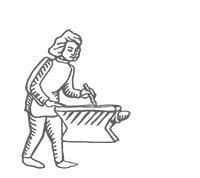|
J. D. Bos an essay on visiting the Museum of Russian Icons [ Part 1 | Part 2 | Part 3 | Part 4 | photo gallery] [ continued ] Museum founder Gordon B. Lankton is owner of the NYPRO corporation based, like the Museum, in Clinton, MA, about 35 miles west of Boston. It was on a business trip to Russia to supervise the opening of a NYPRO subsidiary there that he bought his first icon at a flea market, a depiction of St. Nicholas of Myra. The docent explains that it cost him $25, and that he carried it back to his hotel on a rented motorcycle. The price was low in that era of religious prohibition because the community of faith was hurting, and selling whatever they could. On return trips to Russia, Lankton continued to seek out and purchase icons. Upon his retirement, his wife pointed out that he had acquired more than a hundred, and that perhaps he could find some better use for the collection than filling the walls of their home. Rather than donate or lend his icons to a large established museum for which such items would just be another kind of treasure among many, he decided he would create a niche museum, devoted exclusively to the art of the icon. He walked across the street and bought the old courthouse, stripped the interior down to rough brick and exposed wooden beams, and then rebuilt it in clean plaster and wood paneling. (In the basement cell, the red brick reminds me of Machiavelli's red robe.) After spending about five million dollars between buying the building and renovations, Lankton opened the Museum to visitors in 2006. In 2013, the Museum was visited by over fifteen thousand people. Lankton meets a significant fraction of them personally, emerging from his office on the first floor to greet them and tell them where he bought such-and-such a piece they are admiring. His presence on the scene reminds me of Baltimore dentist Hugh Francis Hicks, described by Michael Kimmelman in The Accidental Masterpiece:
Of course, the story of a sale, however avidly told, doesn't serve the same purpose as a label of provenance. For nearly every icon I inspect, I find that I cannot find information about the creator, place of creation, or even place of purchase. The docent explains that even in the marketplace, icons are treated as living aspects of a true spiritual reality, and buyers and sellers observe a certain protocol amounting to a polite fiction. There is no haggling, nor any explicit exchange of money and ownership. Money is put on the table, the icon is likewise put on the table, and the exchange takes place in an indirect fashion. Does this taboo explain the lack of provenance history? We're left to wonder, since the practical reason for this lack of information isn't apparent from the interpretative materials or guided tour. Given the legal issues involved, the absence of provenance raises worrisome questions. Are the icons over 100 years of age accompanied by a certificate from the Ministry of Culture of the Russian Federation, as per the requirements of Russian law? What are the circumstances that allowed these older works to be exported? Would Russian authorities want to repatriate the Museum's holdings? Might there be something illicit in the display of these artworks so far from their country of origin? These are questions deserving of treatment in the gallery guide brochure at least. * * * |
ISSN 2150-6795 |




